How The Isochain Can Help Transform Your Strength Training by Busting Through Plateaus — for Surprising New Gains in Size and Performance…
by Adrienne Harvey, Senior RKC and PCC
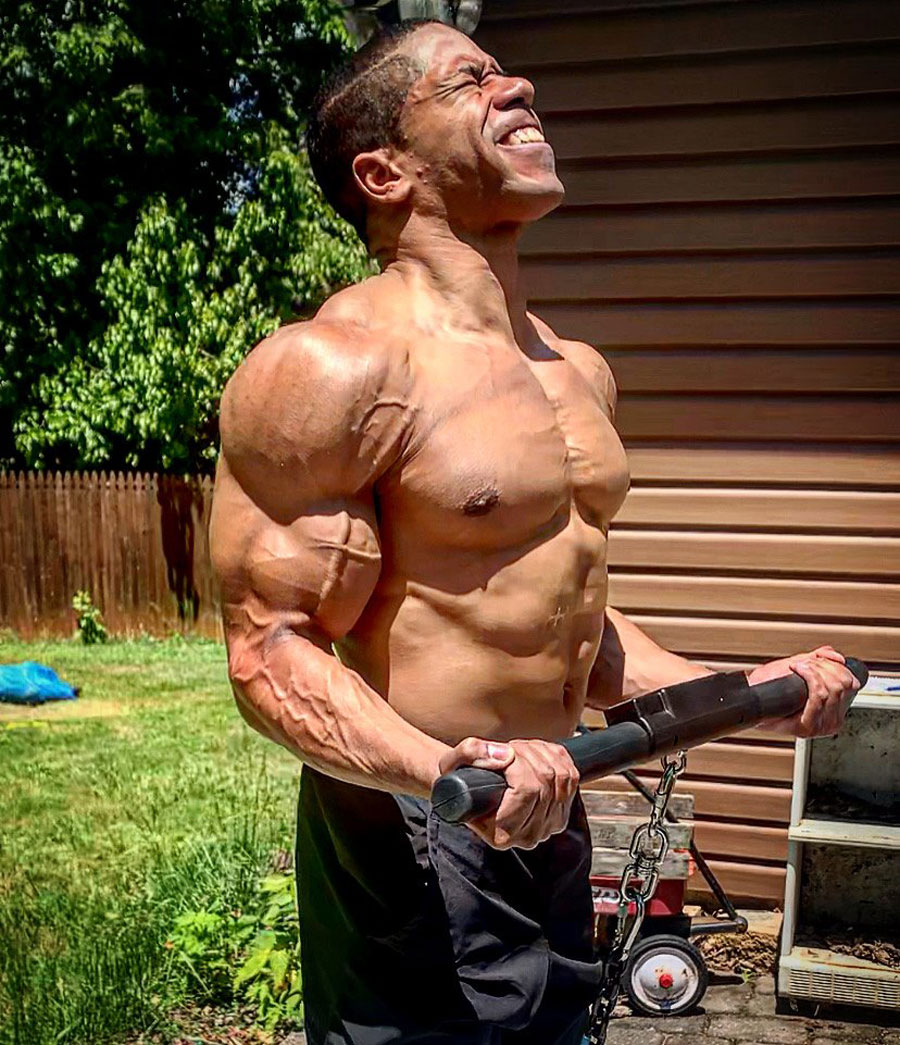
Adrienne Harvey: Today we’re talking with Chrys Johnson. He's a personal trainer, online trainer, and YouTuber. His company is No Limits Fitness. And very importantly, he's been very into the
Isochain for the past year. Chris, why did you decide to take a chance on the Isochain a year ago?
Chrys Johnson: It came down to the pages that I saw from DragonDoor.com on Facebook. On one of the pages there was a photo of Bruce Lee using what I like to call with the No Limit Squad, the "OG Isochain," with the old wooden plank and everything. When I saw that Bruce Lee was using that, it piqued my interest. I knew a little bit about isometric training, but definitely not as much as the wealth of knowledge I saw in
Paul Wade's Isometric Manual. After a few weeks reading all about it I decided to go for it.
Adrienne Harvey: Before the Isochain, what had you been training with primarily?
Chrys Johnson: It was pretty much just weightlifting. Dumbbells, barbells,
kettlebells,
calisthenics, and a very small amount of
isometric training.
Adrienne Harvey: After ordering the Isochain as an advocate, what were your first impressions when that box finally arrived?
Chrys Johnson: I was super excited, and I really wanted to see my numbers—that was the first thing—I wanted to see how strong I am. And I'm probably speaking to 0.01% of people right now, but there's a strong relation of the Isochain and an anime called Dragon Ball Z. So, my inner kid went to see what would happen. I also knew that if in the worst-case scenario, the Isochain was not legit, then I could just return it. So, with nothing to lose I was extremely excited.
Adrienne Harvey: What were some of the biggest benefits you saw early on?
Chrys Johnson: Early on I noticed that many exercises in the gym started to get easier. I'm talking about the lifts I had been struggling with for months--they started to become easier in weeks. I thought, that's not normal! So, I kept training! The only variable that had changed was adding the Isochain. My eating did not change, my cardio did not change, and my weightlifting program did not change. Since this was the only "X-factor", I decided to put it to the test.
In one of my first videos about the
Isochain, I decided to record what would happen if I took 30 days to train only with the Isochain. Here's what happened: I ended increasing my lifts by 65%! What the heck?! Another immediate change was that my joints felt better. My right elbow sometimes suffers from tendonitis, but now (unless I'm doing something really dumb) the pain doesn't come back. It took a little longer for my knees, but after about six weeks, I noticed that my knee pain was gone!
Adrienne Harvey: Wow. That's really exciting. So, with the exercises that you had previously found much more difficult, what kind of plateau were you dealing with before adding Isochain training?
Chrys Johnson: I was struggling to get past a weight and a rep range. I track all my workouts on Google sheets, and had hit a point where I couldn't progress. Normally I progress from six reps to eight, eight to ten, then ten to twelve. Once I can do twelve consistently, I move on to the next weight and start at six reps. That's how I use progressive overload for my training. But I had hit a hard stop, and just couldn't go past a particular number of reps—it just wouldn't move. And increasing the weight also wasn't an option. I was hard-limited on those numbers on multiple lifts until I started using the
Isochain.
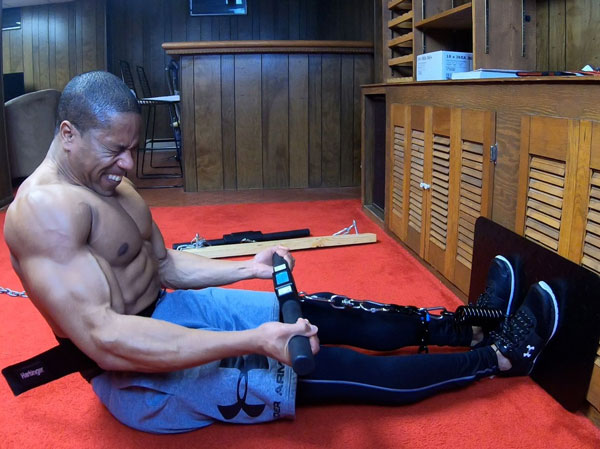
Adrienne Harvey: Which Isochain exercises did you start with first?
Chrys Johnson: This is how nerdy I am—before I even got the Isochain, I had already written down a list of exercises that I was going to do as soon as I got it! So, I immediately got to work on those. I'd chosen 16 exercises that I called the "sweet 16". I made a total body plan—literally from head to toe. I did each exercise one time for six seconds and did this plan for 30 days.
Adrienne Harvey: Since you're a personal trainer, have you been using the Isochain with clients too? If so, what kind of results are your clients getting?
Chrys Johnson: It's been amazing, if I wasn't seeing some of the numbers with my own eyes, I wouldn't believe it! One of my clients who's in a lot of my videos was stuck on a 350 pound deadlift. He's strong and we have been training for about a year and a half at that point. But when he hit 350, that was it, and it was taking everything. Any more and his form started breaking down. So we stopped that. I was still being a Guinea pig with the Isochain first, so we didn’t try that with him for about two months. We decided that we're start adding the
Isochain to his training in January. After we added Isochain training, he went to 375, 380, 395, 400, 410, 450, 475! And then he beats my deadlift max of 510, when he pulled 515 with the Isochain! That's just one example.
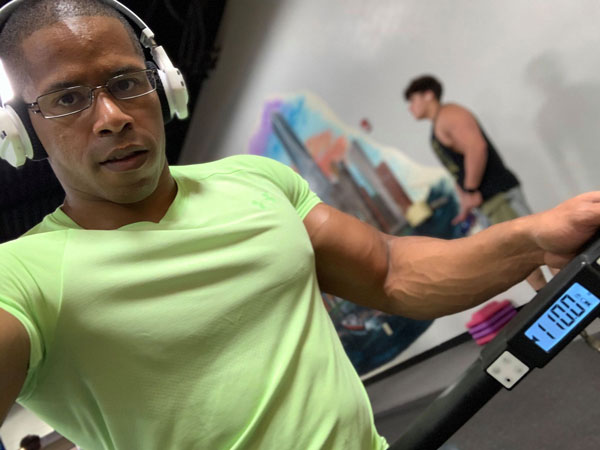
Adrienne Harvey: Which exercises were you training him with? Obviously the Isochain deadlift, anything else?
Chrys Johnson: For him, we just focused on four exercises. Pretty much the major compound lifts: the row, deadlift, Zercher squat and the overhead press. We added a little bit more variation later after getting solid on those four first. But those four exercises were already enough to see a change.
Adrienne Harvey: Now that you've had a year training with the Isochain and training others, what are some of the other ways you've been training with it?
Chrys Johnson: I have another approach I call "the power 45" that introduces hypertrophy—and I don't think I've sworn that much in a 15-minute workout that much before! In it, we're using 60%-80% of the true max. We figure it out by pulling the max for six seconds, and then do the calculation on the phone to find the 60-80% to work with. The burn is out of this world, but I knew it was working!
I based another one off the first story in
Paul Wade's Isochain Isometrics Manual book. The story was called The Springfield Frog experiment. After reading it, I decided to torture myself (and anyone else that wanted to try it.) I made up a "Springfield Frog Routine" which was all hypertrophy. Oh my goodness, it sucked, but it works so well! Everything in that book has just been great, right down to the details. I really appreciate the amount of time it takes to gather all the facts and science.
Adrienne Harvey: What advice do you have for someone who may be just starting with the Isochain, or wondering if it might be a good choice for their training?
Chrys Johnson: It's important that the person training with the
Isochain knows their goals and chooses the right training modality to work towards them. For example, a rock climber might be more interested in endurance holds and finger strength. A powerlifter could prioritize pure power with the holds for up to three seconds. For people like myself who are primarily weightlifters, the six by six or the hypertrophy lifts might be good.
As I start to bring more clients on to
Isochain training, I find myself asking a lot more questions. After a year, I definitely feel more knowledgeable and confident about creating Isochain programs for clients. I wanted to dedicate the first year of using this device to figuring it out, and figuring out how my body responds to certain stimuli, and how some clients also respond to the Isochain. Over the year, I've gathered enough information to know that it's going to be one of the premiere training tools I have to get people results.
Adrienne Harvey: Excellent. And you just answered another one of my questions there. A lot of people might see the Isochain and Dragon Door and think maybe that the Isochain is only for powerlifters or specific types of athletes. But, you and I already know that the Isochain can be very useful for a variety of goals and modalities. How would you explain this to someone who might think the Isochain is just for getting a bigger deadlift or other similar moves?
Chrys Johnson: First, I can definitely understand where they are coming from with that question. And I think that it's important to address people's doubts. The Isochain actually has a variety of purposes, and when people try the Isochain, they start looking at it differently. I've had people see me training with it or training new clients with the Isochain in the gym and they want to know what it is. A couple of guys recognized me from my videos on TikTok with it. Usually, they want to give it a try after we train with it!
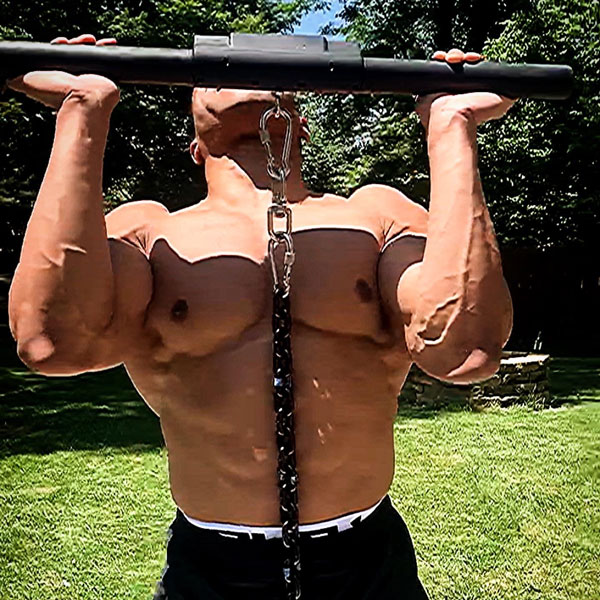
They usually then just see us pushing for six seconds, and I encourage them to try the six seconds, but after they're finished to also try one of the hypertrophy exercises. In 20 seconds we find out their max and then do the math to find their hypertrophy hold time. So now they're sweating and it's only been 20-30 seconds. Then they want to know more! Like, wow, does this thing really work? And I tell them that I have a whole YouTube channel about it and to also check out the DragonDoor.com website to learn more.
Adrienne Harvey: What are some of the biggest mistakes that new users should look out for or avoid when starting with the Isochain?
Chrys Johnson: The number one mistake most new users have is using incorrect form. When people see the Isochain and that there's no movement happening they think they can just rip on it as hard as they can. When teaching new people to use the
Isochain I learned that I really need to coach them through it. At first it actually caught me off guard, because in my mind it's very simple. Last November we were shooting a video with random people at the park trying the Isochain for the first time, and I found that many times I had to help them with their form.
As I train new people on the Isochain I find that I do have to coach them through it—drive through here, don't arch your back, keep your chin up, breathe out—all those cues. I make sure that in the Zercher squat they're not rounding their back out and that you're pushing through your quads—that's a big one. Just as with dynamic training, form is important. So I've been telling people to check out the playlist on my channel where I demonstrate the correct form for each exercise—and to check out the book. The guy with the tattoos in the book does it perfectly.
Adrienne Harvey: It can be surprising to see how few people in the general public have good proprioception. Meanwhile, you've built a lot of good athletic habits. How long have you been lifting—on your own and as a trainer?
Chrys Johnson: I've been a personal trainer for over five years, and this January 1st, I will have been lifting for 13 years straight.
Adrienne Harvey: What's next for you and your training?
Chrys Johnson: I'm definitely interested in exposure with the
Isochain In fact, I recently did an interview with one of my clients and her husband for a YouTube channel. Her husband had massive tendonitis and after training with the Isochain it's gone. I just know how much beneficial it can be.
As for my own training, the Isochain is going to continue to be a mainstay. Honestly it's at the point where I can't afford not to use it because of my knees. There's just no way that I'd be able to continue to train at the intensity that I'm interested in without the Isochain. I know how sensitive the connective tissues are and how they can break down as we get older. I'd be foolish not to train with it. After a year I know which modes work for me and which don't—and now that I have that information, it's time to get serious!
I've been designing new programs that I call hybrid weightlifting (weightlifting, Isochain, calisthenics) which use the Isochain and don't conflict with other elements of training. I want to design the programs with the Isochain so that it works in harmony to get results a lot faster and safer. Right now I am utilizing it to the best of my ability and getting gains that would have otherwise taken a lot longer without the Isochain.
Adrienne Harvey: Very cool. So I have a tough question for you—what's your favorite or your top three Isochain lifts?
Chrys Johnson: The bicep curl is one, and I really like an underrated one—the hack lift, I love how it feels on my quads, honestly, it's like a volcano—it's surprising.
The hack lift is number three, bicep curls, number two. But I have a love-hate relationship with my number one Isochain exercise, the Bulgarian split squat! It burns so much, like my glutes are on fire, my quads are on fire. In the book, it's taught in a front squat manner, but my wrists just don't work that way, so I use a Zercher hold. But, I honestly believe that half of the reason my knees got better is because of that one exercise and the direct amount of pressure it places on one leg. That exercise by itself is worth its weight in gold with the Isochain. I highly recommend that exercise.
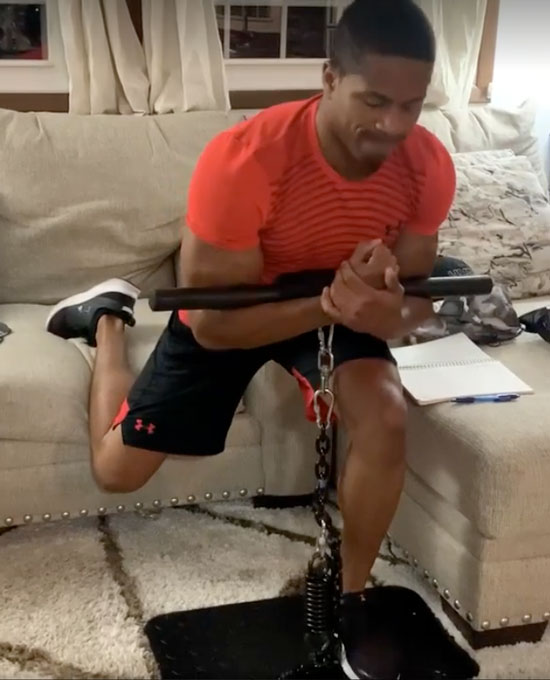
Adrienne Harvey: I'll have to try that! Is there anything else you'd like us to know about you and your experiences with the Isochain so far?
Chrys Johnson: I've been telling a close group of friends that I won't be surprised if one day I see NFL athletes training with the Isochain. Having the display on the bar changes the whole face of
isometric training with the load mode, time mode and seeing the visual display of your force. I think most pro athletes—once they understand the science of it—will see how much it will affect their game. So, I expect to see it on TV, maybe not now, but soon.
Adrienne Harvey: People sometimes ask why they can't just get a chain, a stick, and a piece of wood to stand on like the old photos of Bruce Lee. Of course try it, and it's how many people get started with isometrics, but the features like the display itself and the heavy duty spring for zero loading reflex really make the Isochain incredibly different.
Chrys Johnson: I'd like to add something to that, speaking of the DIY version. On my YouTube channel, I've told people many times that there's nothing wrong with it. In fact I made my own version with about $40 at Home Depot—it's downstairs right now. And when I trained with it I noticed changes, but the loading reflex from it is too great to make it sustainable over long periods of time. And then you don't know how much force you're generating—it's like going to the gym and all the dumbbells are marked with question marks instead of their weight!
One of my oldest, coolest clients came over to train, and showed me that he had made his own isometric setup and did a very good job with it. He's going to use it at home between our sessions with the
Isochain. I told him it was awesome, but I thought he'd end up wanting one of his own, or at least the stand alone bar!
Back